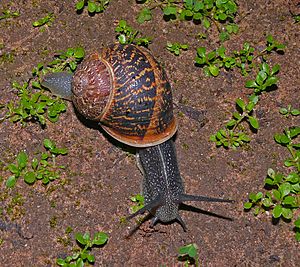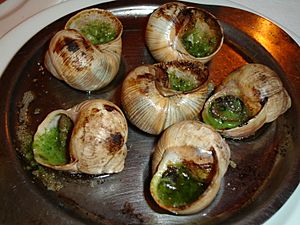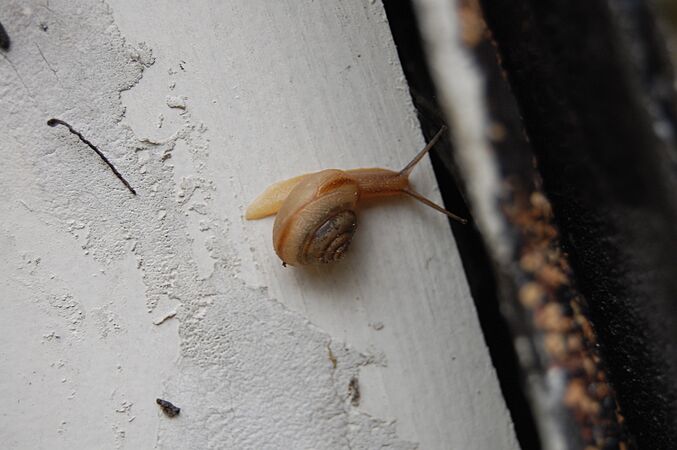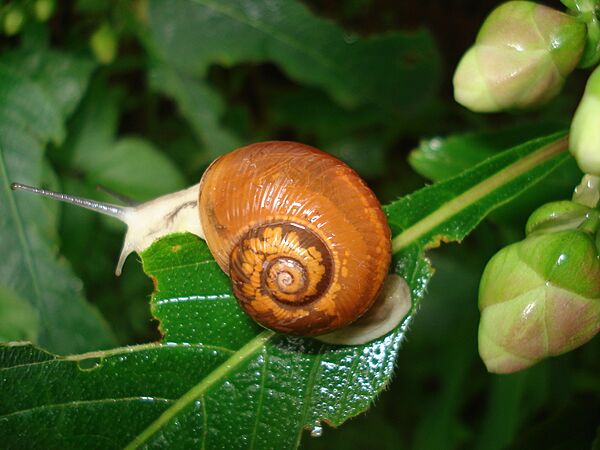Land snail facts for kids
A land snail is a type of snail that lives on land, unlike sea snails or freshwater snails. They are a kind of mollusk called a gastropod that has a shell. Snails without shells are known as slugs. It can sometimes be tricky to tell if a snail is truly a land snail, as some can live in both land and fresh water, or even land and salt water.


Most land snails are called pulmonates, which means they have a lung and breathe air. Other land snails, like those in the group Caenogastropoda, often have a gill and a special lid called an operculum. Many of these snails live in damp or wet places, like in moss.
Land snails have a strong, muscular foot. They use mucus (a slimy substance) to help them crawl over rough surfaces and to keep their soft bodies from drying out. Like other mollusks, they have a mantle, which is a special layer of tissue. They also have one or two pairs of tentacles on their head. Inside their bodies, they have a radula (a ribbon-like tongue with teeth) and a simple brain.
When it comes to having babies, many land snails are hermaphrodites. This means they have both male and female reproductive organs. Most of these snails lay groups of eggs in the soil. Tiny snails hatch from these eggs with a small shell already in place. The shell then grows in a spiral shape as the snail gets bigger. Most land snail shells coil to the right.
Many different animals, both vertebrates (like birds) and invertebrates (like beetles), eat land snails. Humans also eat land snails in many parts of the world, and some snails are even raised on farms for food.
Contents
Biology
How Do Snails Move?
Land snails move by gliding on their muscular foot. This foot is covered with mucus and tiny hairs called cilia. The snail moves by making waves of muscle contractions along the bottom of its foot. You can easily see this if a snail is crawling on a window! Snails are very slow, usually moving about 1 millimeter per second.
Snails produce mucus to keep their soft bodies from drying out. They also use mucus from their foot to help them move by reducing friction. This mucus also protects them from sharp objects, so they can crawl over a sharp edge without getting hurt. The mucus leaves a shiny "slime trail" behind them, which you can often see for hours.
What is a Snail's Shell For?
Most mollusks, including land snails, have a shell. The shell is part of their body from when they are very young, and it grows with them. The snail's mantle (a special tissue layer) creates the shell by adding new calcium carbonate material. This new material is added to the open edge of the shell, and also on the inside to make it stronger.
Because of how it grows, the center of the shell's spiral was made when the snail was young, and the outer part was made when the snail was older. Most land snails need a good supply of calcium from their diet and environment to make a strong shell. If they don't get enough calcium, or if their surroundings are too acidic, their shells can become thin, cracked, or even have holes. Snails can usually repair small damage to their shells if conditions improve, but severe damage can be deadly.
When some snails pull back into their shells, they can close the opening with a door-like structure called an operculum.
Land snails come in many different sizes. The largest living species is the Giant African Snail (Achatina achatina), which can grow up to 30 centimeters (about 12 inches) long!
Snail Senses and Digestion
Most land snails have one or two pairs of tentacles on their heads. In many land snails, the eyes are on the upper pair of tentacles, which are sometimes called 'eye stalks'. The lower pair of tentacles are used for smelling. Both sets of tentacles can be pulled back into the snail's head.
A snail eats by using its radula, which is inside its mouth. The radula is like a ribbon with rows of tiny teeth. The snail scrapes food with this radula, and then the food goes into its digestive system. If it's very quiet, you can sometimes hear a large land snail "crunching" its food as the radula scrapes it.
A snail's brain is quite simple, made of groups of nerve cells called ganglia. Even with a simple brain, snails can learn things, like remembering certain associations.
How a Snail's Shell Grows
As a snail gets bigger, its calcium carbonate shell also grows. New shell material is added by special glands in the snail's mantle to the edge of the shell's opening. This means the center of the shell's spiral is the oldest part, and the outer part is the newest. When a snail reaches its full adult size, it might build a thicker lip around the shell opening. At this point, the snail stops growing and starts to reproduce.
A snail's shell forms a logarithmic spiral, which is a special kind of curve. Most snail shells coil to the right, which is called dextral coiling. This means if you hold the shell with the tip pointing towards you, the spiral goes in a clockwise direction.
Hibernation and Estivation
Some snails go into a deep sleep called hibernation during the winter, usually from October to April in the Northern Hemisphere. They might also go into a similar state called estivation during hot, dry summer conditions. To stay moist and safe during these times, a snail seals its shell opening with a dry layer of mucus called an epiphragm.
Reproduction and Life Cycle
Most land snails are hermaphrodites, meaning they have both male and female reproductive organs. This allows them to produce both sperm and eggs. A few types of land snails, however, have separate sexes (male and female). Snails reach sexual maturity at different ages, from as early as 6 weeks to 5 years, depending on the species. Bad environmental conditions can sometimes delay this.
Many air-breathing land snails perform special courtship behaviors before mating, which can last for several hours. In some snail families, before mating, one or more "love darts" are shot into the partner's body.
Pulmonate land snails are very good at having babies. They usually mate in pairs and fertilize each other's eggs internally. They do this through a reproductive opening near the front of their body, where their reproductive organs come out to exchange sperm. After fertilization, the eggs develop. Each group of eggs can have up to 100 eggs!
Garden snails usually bury their eggs in shallow topsoil, about 5 to 10 cm deep, especially when the weather is warm and damp. The size of the eggs varies by species; for example, a grove snail's eggs are about 3 mm wide, while a Giant African Land Snail's eggs can be 6 mm wide. After 2 to 4 weeks of good weather, the eggs hatch, and young snails emerge. Snails can lay eggs as often as once a month.
How Long Do Snails Live?
Most land snail species live for about a year, while others live for 2 or 3 years. However, some of the larger species can live for over 10 years in the wild. For example, the Roman snail (Helix pomatia) can live for 10 years or more in nature. In captivity, snails can live much longer; for instance, H. pomatia can live up to 25 years when cared for by humans.
What Do Snails Eat?
In the wild, snails eat many different kinds of food. Most land snails are herbivorous, meaning they eat plants like leaves, stems, soft bark, fruits, vegetables, fungi, and algae. Some species can cause damage to farm crops and garden plants, so they are sometimes seen as pests. However, some land snails are carnivores (meat-eaters) or omnivores (eat both plants and meat). For example, the Powelliphanta genus includes the largest carnivorous snails in the world, found in New Zealand.
Who Eats Snails?
To protect themselves from predators, land snails pull their soft bodies into their shells when they rest. Some even bury themselves in the ground. Land snails have many natural predators, including birds like thrushes, hedgehogs, and certain snakes. Invertebrate predators include other snails like decollate snails, ground beetles, leeches, and even some predatory caterpillars.
Sometimes, snails can be infected by tiny flatworms. For example, the marsh snail (Succinea putris) can be infected by a flatworm called Leucochloridium paradoxum. These flatworms make the snail's eye stalks swell up and pulse, which attracts birds. When birds eat the eye stalks, they also eat the flatworms, which then complete their life cycle inside the bird.
Human activities like pollution and destroying habitats are also big threats to snails in the wild. Many snail species have become extinct in recent years because of this.
Snails as Human Food
People have been eating land snails for thousands of years. There is evidence of snail eating from ancient sites around the Mediterranean Sea.
However, it's important to know that wild snails that are not cooked thoroughly can carry a parasite (Angiostrongylus cantonensis) that can cause a rare type of meningitis (a serious brain infection). So, if you ever eat snails, make sure they are cooked properly!
Snail eggs, sometimes called snail caviar, are also a special food that is becoming more popular in Europe.
Snails in Africa
In parts of West Africa, like Ghana, snails are a popular food. The Achatina achatina, or Ghana tiger snail, is one of the largest snails in the world and is eaten there. In Nigeria, snails are called "igbin" in the Yoruba language and are a widely enjoyed food. In Cameroon, snails are a delicacy, especially in the South West region.
In North Morocco, small snails are eaten as snacks in a spicy soup.
Snails in Europe
Snails are eaten in several European countries, just as they were in the past in the Roman Empire. Three main species are usually eaten:
- Helix pomatia, also known as the edible snail or Roman snail. It's often prepared in its shell with parsley butter. This snail is typically found in Burgundy, France, and is known as l'Escargot de Bourgogne.
- Helix lucorum, found around the Eastern Mediterranean, is commonly eaten in Greece and parts of Georgia.
- Cornu aspersum, also known as the European brown snail or garden snail. It's cooked in many different ways depending on local traditions. This snail is found in Mediterranean countries and the French Atlantic coast.
In French cuisine, snails are called escargots. Many snail farms exist in France to produce them. Before cooking, snails are usually kept without food for a few days, then fed flour and water for a week. This helps to clean them.
Snails are also popular in Portuguese cuisine, where they are called caracóis. They are often served in snack bars, usually stewed with white wine, garlic, piri piri, oregano, and other herbs. Larger snails, called caracoletas, are often grilled with butter sauce. Portugal eats about 4,000 tonnes of snails each year!


Traditional Spanish cuisine also includes snails, called "caracoles" in Spanish. They are very popular in regions like Andalusia and Catalonia. There are even snail festivals, like "L’Aplec del Caragol" in Lleida, which attracts many visitors. Small to medium-sized snails are often cooked in spicy sauces or soups. Larger ones might be used in dishes like "arroz con conejo y caracoles" (rice with snails and rabbit meat).
In Greece, snails are especially popular on the island of Crete. They are eaten boiled with vinegar, or cooked alive in a casserole with tomato and potatoes. A traditional Cretan dish is Kohli Bourbouristi, which is fried snails in olive oil with salt, vinegar, and rosemary.
In Sicily, snails (called babbaluci) are a very popular dish. They are usually boiled with salt, then served with tomato sauce or just with oil, garlic, and parsley. Snails are also enjoyed in other Italian regions.
On the island of Malta, snails (called bebbux) are prepared and served in a similar way to Sicily.
In southwestern Germany, there's a regional soup specialty called "Black Forest Snail Chowder" (Badener Schneckensuepple), made with snails and herbs.
Heliciculture is the farming of snails. Some species, like the Roman snail, are protected in the wild in several European countries and cannot be collected. However, the Roman Snail and the Garden Snail (Cornu aspersum) are raised on snail farms.
Snails in Oceania

In New Caledonia, a snail called Placostylus fibratus (known as bulime) is considered a very special food. It is farmed locally to make sure there are enough for people to eat. Restaurants often serve it prepared in the French style with garlic butter.













